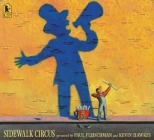Oddly, we don't have a lot of wordless books in this household. (Or perhaps, it being this household, it's not odd at all.) We adore Good Night, Gorilla, which I think you gave us when Eleanor was quite small, and which is so rewarding to read and re-read and examine. It's funny; it's not technically wordless, as the zookeeper does say good night to each animal, and towards the end, the animals all say good night as well, but the words don't cover the bulk of the story. We've read it in various different ways. For a while, we had the standard things we'd say on each page ("And now the gorilla is using the blue key to open the blue cage...."), and then once Eleanor was old enough, we'd ask her questions about what was going on in each picture. I don't think she focused on reading this one alone more often than books with words. Of course, with so many of our picture books, she knows much of the text by heart anyway.
Mulling over wordless or almost-wordless books made me think of one of our favorite good night books, which is extremely quiet and simple and includes three page spreads with no text at all.

Grandfather Twilight
We received Barbara Berger's Grandfather Twilight as a gift from a colleague of mine shortly after Eleanor was born. This was lucky, because it's not a book I would have bought for myself had I run across it in a bookstore. Flipping through it for the first time, I found the illustrations cloying, rendered in soft-focus, and the story nothing gripping. But I was wrong. Eleanor loved the book immediately. In it, Grandfather Twilight takes a pearl from his trunk each night, then walks through the woods, into open ground, and out to the sea (these are the wordless pages). The pearl grows larger in his hand as he goes, and he lifts it up at the water's edge to become the full moon, then walks back home. It's a slow, gentle story, and the paintings grow on you quickly. We read it often.
A wordless book we discovered this year is by the multi-talented Paul Fleischman (author of a wide variety of children's books, including the terrific Joyful Noise: Poems for Two Voices and Seedfolks -- is there anything he can't do?).

Sidewalk Circus
Sidewalk Circus depicts a girl waiting at a bus stop and looking at the street around her. There are signs and posters advertising the coming circus (they provide the only text), and as she looks around, the everyday activities of the people on the street are transformed into circus acts: a cook in a restaurant window flips pancakes, while her shadow is that of a juggler, etc. It's a fun one to explore with a kid, especially someone who has been to a circus.
It seems to me, thinking about it like this, that often wordless books are good for slightly older kids, so they can talk through them and discover the stories for themselves.
Love, Annie

I'm so glad someone gave you Grandfather Twilight! Both Lizzie and Mona were very fond of it when they were in the 2-4 range. It's mesmerizing.
ReplyDeleteI love the David Weisner books! Barbara Lehman's wordless books are good, too (The Red Book is my favorite), though also better for kids 5ish and up. Virginia loves Elephant Buttons by Noriko Ueno and Three Topsy-Turvy Tales by Anne Brouillard -- both are accessible to 3 year olds.
ReplyDelete